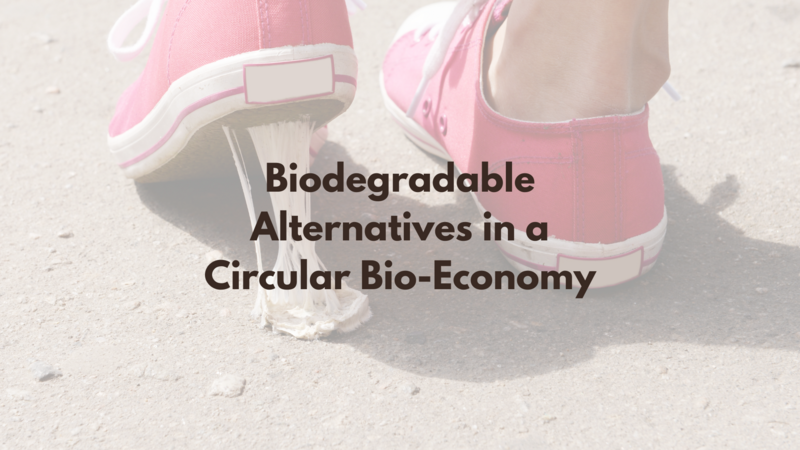The Role of Biodegradable Alternatives in a Circular Bio-Economy
In an era where plastic pollution has burgeoned into a global environmental crisis, the urgency to find sustainable solutions has never been more pressing. Our rivers, oceans, and landscapes are inundated with plastic waste, a testament to the inadequacies of current plastic management practices. The nova-Institute publication "BioSinn – Products for which biodegradation makes sense" aims to identify and analyze products and applications where biodegradation is environmentally beneficial but also practical and economical.
The world's reliance on plastic, characterized by its durability and versatility, has led to an exponential increase in production. From packaging materials to consumer products, the omnipresence of plastic is undeniable. However, its resilience, once celebrated, is now a double-edged sword. Conventional plastics, derived from non-renewable fossil fuels, take centuries to degrade, leading to severe environmental pollution and health risks. The situation is exacerbated by the limitations of current recycling technologies, which struggle to cope with the diversity and volume of plastic waste. Most plastics end up in landfills or the environment, contributing to an ecological catastrophe.
The future envisioned by MIX-UP is one where plastics no longer pose an environmental threat but are integral to a sustainable economic system. As we grapple with the plastic crisis, initiatives like MIX-UP are not just innovative; they are essential. Biodegradable plastics are materials that can decompose into natural substances like water, carbon dioxide, and biomass with the help of microorganisms. Unlike traditional plastics, which persist in the environment for centuries, biodegradable plastics offer a more eco-friendly end-of-life option. This category includes bio-based plastics derived from renewable resources like corn starch or sugarcane and bioplastics engineered for biodegradation.
The nova-Institute publication "BioSinn – Products for which biodegradation makes sense" aims to identify and analyze products and applications where biodegradation is environmentally beneficial but also practical and economical. The focus is on exploring the viability of biodegradable materials in various sectors, emphasizing the need for a shift towards sustainable alternatives in product design and disposal.
The BioSinn project is particularly interested in applications where biodegradable materials can offer significant advantages over traditional, non-degradable plastics. These advantages might include reduced environmental impact, especially in contexts where recycling is challenging or not feasible, and in applications where products are likely to end up in natural environments where they can cause harm, such as in oceans, waterways, or land.
Key areas explored by BioSinn include packaging, agriculture (e.g., mulch films and seed tapes), consumer products (e.g., cutlery, plates, and straws), and other niche applications where biodegradable materials could offer environmental benefits. The initiative seeks to provide a comprehensive overview of the current state of biodegradable materials, their potential applications, and the environmental considerations associated with their use.
By highlighting products for which biodegradation makes sense, the BioSinn project aims to encourage policymakers, industry leaders, and consumers to consider sustainable alternatives to conventional plastics, ultimately contributing to reducing plastic waste and promoting a circular economy.
Chewing Gum
Traditionally, chewing gum, made from synthetic polymers that degrade into microplastics, has been a persistent environmental nuisance. However, natural alternatives like chicle gum present a biodegradable solution. Innovations in this space include gums based on natural latex or bioplastics like PLA, which ensure that they break down into harmless organic compounds once discarded, reducing urban pollution and cleaning costs associated with gum removal.
Bristles for Sweeping Brushes
The bristles on sweeping brushes, often made from polypropylene, contribute to plastic release into the environment. Biodegradable alternatives, including bristles made from starch blends or PLA, offer an eco-friendly substitute. These materials ensure that as bristles wear down, they don't add to microplastic pollution, instead breaking down into natural elements, making urban cleanliness compatible with ecological sustainability.
Tea Bags and Coffee Pods
The ubiquity of tea bags and coffee pods in daily consumption makes them prime candidates for sustainable innovation. Biodegradable materials like cellulose fibers, abaca, and bio-based films are now used to manufacture tea bags and pods that decompose naturally. This switch addresses the waste management issue and aligns with consumer demand for greener products.
Biowaste Bags
Biowaste bags play a crucial role in collecting and composting organic waste. Traditionally made from PE, these bags hindered the composting process. The introduction of bags made from biodegradable plastics, such as PLA and PBAT blends, has facilitated the efficient composting of organic waste, reducing contamination and enhancing the quality of compost produced, thus supporting the circular economy.
Stickers for Produce
Stickers on fruits and vegetables are a small but significant source of plastic waste. Biodegradable alternatives, printed with eco-friendly inks and adhered with natural adhesives, ensure that these stickers do not contaminate compost or the environment, making the disposal of fruit and vegetable peelings more sustainable.
Leg Bands for Birds and Wild Animals
Leg bands used for tracking and research purposes traditionally contained non-biodegradable plastics. Biodegradable alternatives ensure that these essential tools for wildlife research don't contribute to environmental pollution, breaking down harmlessly once they've served their purpose.
Mulch Films and Plant Fixing Clips
In agriculture, mulch films and plant fixing clips from conventional plastics contribute significantly to soil pollution. Biodegradable alternatives, made from materials like PLA, PBAT, and starch blends, provide the necessary functionality while ensuring that they break down into non-toxic components, supporting soil health and reducing agricultural pollution.
These applications of biodegradable plastics illustrate the feasibility and importance of transitioning away from conventional plastics. By integrating biodegradable materials into everyday products and industrial applications, we're taking essential steps toward reducing plastic pollution and fostering a sustainable, circular economy. The innovations highlighted here are just the beginning, with the potential for biodegradable plastics extending far beyond these examples, promising a cleaner, greener future.
Read more: To the publication


